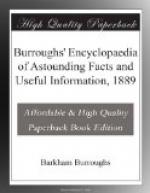WASH FOR TEETH AND GUMS.—The teeth should be washed night and morning, a moderately small and soft brush being used; after the morning ablution, pour on a second tooth-brush, slightly dampened, a little of the following lotion: Carbolic acid, 20 drops; spirits of wine, 2 drachms; distilled water, 6 ounces. After using this lotion a short time the gums become firmer and less tender, and impurity of the breath (which is most commonly caused by bad teeth), will be removed. It is a great mistake to use hard tooth-brushes, or to brush the teeth until the gums bleed.
TETTER.—After a slight feverish attack, lasting two or three days, clusters of small, transparent pimples, filled sometimes with a colorless, sometimes with a brownish lymph, appear on the cheeks or forehead, or on the extremities, and at times on the body. The pimples are about the size of a pea, and break after a few days, when a brown or yellow crust is formed over them, which falls off about the tenth day, leaving the skin red and irritable. The eruption is attended with heat; itching, tingling, fever, and restlessness, especially at night. Ringworm is a curious form of tetter, in which the inflamed patches assume the form of a ring.
TREATMENT—Should consist of light diet, and gentle laxatives. If the patient be advanced in life, and feeble, a tonic will be desirable. For a wash, white vitriol, 1 drachm; rose-water, 3 ounces, mixed; or an ointment made of alder-flower ointment, 1 ounce; oxide of zinc, 1 drachm.
TO REMOVE TAN.—Tan may be removed from the face by mixing magnesia in soft water to the consistency of paste, which should then be spread on the face and allowed to remain a minute or two. Then wash off with Castile soap suds, and rinse with soft water.
CARE OF THE TEETH.—The mouth has a temperature of 98 degrees, warmer than is ever experienced in the shade in the latitude of New England. It is well known that if beef, for example, be exposed in the shade during the warmest of our summer days, it will very soon decompose. If we eat beef for dinner, the particles invariably find their way into the spaces between the teeth. Now, if these particles of beef are not removed, they will frequently remain till they are softened by decomposition. In most mouths this process of decomposition is in constant progress. Ought we to be surprised that the gums and teeth against which these decomposing or putrefying masses lie should become subjects of disease?




